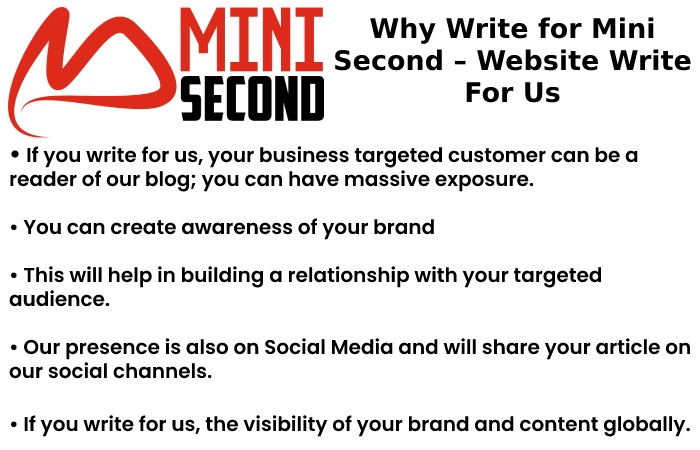Website Write For Us – How many of your clients would recommend you to their friends and/or family? If you don’t know, you have a severe problem. We suggest you use the Net promoter score (NPS), an indicator that helps measure customer loyalty; yes, as long as it is combined with other indicators used to improve the customer experience and business processes.
Website Write For Us
It isn’t easy to define what a loyal customer is. First, we start with the user who has paid for your products and services. But, the ‘simple’ fact of producing is not a sign of 100% loyalty either because it is probable that this user is a ‘captive’ client of your business. For example, you are a client of a financial institution with which you have had a mortgage contract for many years; or from an insurer with which you have insurance (or several), or from a telecommunications company with which you have a permanent contract, or you buy a particular product or service that you need and that only has a specific company…
In these cases, it is possible (and likely) that all these companies, despite having ‘captive’ customers, work very well on the customer experience. Still, perhaps those customers do not consider the possibility of being loyal to that brand because they do not see any added value in them beyond having a contractual obligation.
The first option
As Francisco Carrero, co-founder and CEO of BrainSINS, maintains, it is difficult to define, but it could be the one that does what we want it to do when it visits us. «It would be something like that every time a customer has to buy something that you sell; he goes to your business instead of going elsewhere. In short, he has you as a top of mind, as a first option ».
Loyalty has to be aligned with your business objective, that is, that the user does and repeats what you are interested in doing in your business, whether it is reading content, buying from you or something else. It depends on your business model, points out José Carlos Cortizo, co-founder and CMO of BrainSINS, “because, for example, for a communication medium, the loyalty of its readers is that they return to its website [and more visits, more advertising sales ]. But in eCommerce, which is more transactional, it doesn’t matter if the user visits you 50 times if they don’t buy any. Imagine that you are the reference blog for lovers of a specific sport, but they don’t buy from you. In the end, you are not getting good loyalty because your business is interested in selling.
For example, companies like Amazon or Thomann “have positioned themselves as top of mind, as the first option in the minds of users, who, although they do not end up buying in those stores, do go to them as an information channel and, in many times, they will end up buying.
Ultimately, customer loyalty, these experts maintain, has to do with customer experience “and, on many occasions, that experience does not always have to do with price, but rather with the knowledge that surrounds a purchase: because of the trustworthy service, purchasing facilities, returns, etc. “, emphasizes Carrero.
How do we measure it?
In addition to being difficult to define, it is not easy to measure the customer experience, the results, the loyalty… «The classic thing measured in loyalty is the analysis of recurrence cohorts, that is, how many customers repeat a purchase in X months? (3, 6, 9, 12…) and make X purchases at the same time (1, 2, 3, 4…)?” this is very difficult to do, says Cortizo, because “it varies a lot throughout the time and that, either you have a lot of volumes, or if you have, for example, 100 orders a month, those ratios can vary a lot from one month to another».
In addition, sale is not always a good indicator of the customer experience. Why? “Imagine, for example, Black Friday. Maybe people buy from you, but their customer experience has been horrible, and they won’t repeat it. Could you use conversion to measure customer experience? No, because it depends on the acquisition channel used, the campaigns there, the promotions… and a series of other things that do not have so much to do with the customer experience or loyalty. And all that can change. And that is where the Net Promoter Score comes in, which, although it has many imperfections, allows me to measure, more or less, if my users are more or less happy”, warns Cortizo.
See more más
The NPS [ at the end of this article, we explain the formula in detail ] is not a panacea, but it is easy to use and implement. This expert remembers that this tool measures the answer to the question of whether you recommend me. And always in the future and as a potential.
If we analyze it in depth, it does not have a direct relationship with the customer experience, although it will influence it because if a customer has a bad knowledge, they will not recommend us, while if they have a good one, there will be a greater chance that they will recommend. But also, you can have a good experience and not recommend our product or service because it’s not that vital to your life. There are so many variables in the purchase process that it is tough to measure all this with a simple question: you, as a company, can be very good at providing the service, but then your logistics company messes up, and the experience of that Customer ends up being disastrous.
Website Write For Us
Another aspect that you must take into account is how the NPS is calculated (the number of promoters minus the number of detractors): «If you have 1,000 of each –Carrero states–, your NPS is zero, and if you have 1,020 promoters and 980 detractors, your NPS is 40, but the ratio remains practically the same because more or less half of your customers are promoters and the other half are detractors. This indicator is not a perfect measure and is far from being one, but, at least, it is a first step for companies to become aware of the need to measure”.
For these experts, it is interesting to compare your NPS with what you have been obtaining over time, with competition and the average for your sector. That will let you know how much room for improvement you have achieved and how much more you can improve.
Website Write For Us
Cortizo points out that it does not make much sense to compare your NPS with companies from sectors or markets other than yours “because, for example, if you compare a telecommunications service with Netflix, by default, you will put the telecommunications service below.
Because it is a commodity, more oriented to general consumption. Your NPS doesn’t have to be 100 to be very good, but it should be better than your competition or better than previous periods. For example, there are negative NPS, unfortunately, in very complicated sectors, which can be good. If you were -10 before and now you are -8, that means you have evolved. And if, in addition, you compare yourself with your competition that before had -20 and now has -30, then you are doing much better. That means you have a lot of room for improvement.
Website Write For Us
And suppose you are in a very mature vertical. In that case, it will be tough to exceed 20, 30 or 40 NPS points because, inherently, customers in that market are not going to find your service good enough to recommend it because to recommend it. Something, it has to have a powerful impact on the Customer.”
Let’s be proactive
The NPS is nothing more than a piece of data. And it will only be really ‘productive’ if you use it to do different things, such as establishing communication channels not only with those who favour your brand, such as promoters, but also knowing what your detractors don’t like to improve. Their experience and also what you can do to turn passives into promoters.
For example, the company Customer, a comprehensive intelligent marketing platform focused on the client, links the NPS to specific labels that allow knowing the relationship between positive and negative responses with particular areas, strategies and services. They measure the quality of the experience and its relationship with improving certain aspects, something that the NPS, globally, does not offer.
“As a prior step to be able to activate the promoters of a brand and become ambassadors and recommenders, we needed to know how many of their clients were promoters of that brand,” recalls Tampa Soares, customer success manager at Customer. Based on the NPS, this company has developed a tool to measure customer loyalty.
“There are other indicators, such as satisfaction surveys, customer satisfaction rates… to measure the customer experience, but the NPS is straightforward to implement and explain to our customer companies,” Soares clarifies.
Website Write For Us
Customer’s tool links NPS results with ROI and profit: “With our solution, companies can see and compare their economic data with the three NPS customer segments. They can see the differences at the economic level of those segments and estimate the income that they are at risk since detractors (those who have had a bad experience with the brand) are likely to stop buying or reduce their purchases in the future. For example, they may know the value of a promoter, who spends 30-50% more than a detractor. We can tell companies how likely they will reduce a percentage of that revenue in the future.”
Soares points out that “it is usually taken for granted that the more satisfied customers you have, the more you will sell, but that statement needs to be supported by numbers to prove it, and our technology makes it possible to do so. By analyzing a company’s customer database and knowing, thanks to the NPS, how many are satisfied (promoters) and how many are not (detractors), we can calculate how much future revenue is at risk or how to increase it. For example, we can motivate promoters to increase their purchases, refer more people to us, and generate more value and future revenue for the brand.”
Linked to purchase
The NPS can be done in two ways: transactional, that is, after a sale, when X days have passed, customers are asked the question related to that recent purchase. And also the relational NPS, “which many companies do several times throughout a year to find out the percentage of customers who would recommend their brand,” says Soares, who stresses that “the critical thing about NPS is not so much the number itself, but the evolution and feedback we get from customers, and that will serve to improve because, after the NPS question, we attach another open field question, in which we ask: Why did you give us that score? And there they tell us the reasons for whether they would recommend us or not.
Analyzing these results allows companies to know which areas or aspects should be improved and which ones to strengthen. «Our technology allows us to implement this second question on the company’s website so that they decide when to ask it, or they can send it by email to their clients. Of those who answer the first question, more than 70% explain the reasons. That’s valuable because companies can analyze all that feedback and conclude. Moreover And all this information is provided to companies so they can solve their problems. And if we add the numerical factor of ‘so much has been spent’, ‘so many times’, etc., companies can know the future income at risk and potential profits”, Soares emphasizes.
And don’t forget about passives!
It may seem that only promoters and detractors are ‘important’, but passive or neutral ones should not be forgotten because they play an essential role. “They are indeed ruled out in the NPS formula (promoters minus detractors) to achieve a very demanding metric when it comes to assessing the customer experience, but they must be paid a lot of attention,” this expert points out.
«They are customers who are happy but not satisfied enough. If there is any change in price, service, etc., they will likely go to another company because they have no compelling reason to be with you. And it could be alarming that the percentage of passive customers was very high. If you have, say, 40% passive, you leave very little room for promoters and detractors, and your NPS will be very low [or very high]. Therefore, it is important to pay courtesy to them. Know why they are happy but not quite, and how to improve their state. Passives usually say some positive aspects of the brand and also negative or less positive. In the first aspect, it must be reinforced and, in the second, attend to and solve it”, explains Soares.
Website Write For Us
It is also essential to compare the responses of detractors and passives to see if they agree on the negative aspects that need to improved. “It is true that the passive Customer is the most difficult to please. A detractor complains and is passionate, as is the promoter. And turning a complaint into a sales opportunity is always easier than taking action in the face of someone who, as her name suggests, is passive. However, you always have to work with the liabilities, even with those who have not given us the reasons. We always look for a way for them to answer us so that their experience is 10.
Gemma Muñoz, CEO and co-founder of El Arte de Medir, assures that liabilities are fundamental “because we are interested in knowing what we are doing wrong so that this group appears neutral; in addition, they are the ones that end up going to the competition without a word. Anything other than recommending is alarming and a sign that things not being done right. And if the passive percentage is very high, it is alarming. If we ‘save’ in the CRM, the NPS associated with the client, we can design campaigns aimed at both passives and detractors, in which they are told that they have been heard and that we are going to work to solve those problems».
Website Write For Us
Muñoz recommends segmenting the NPS results: «We collect information from both physical and online stores and inquire about the reasons the surveyed customers give us. We segment by type of product purchased geographical area in which you are answering us, if it is your first purchase or if you are a repeat offender… The NPS is the starting point to act from there and evolve. The only way to move forward overcoming bugs is to segment those responses to dig deeper into the issues and try to make things better.”
Encourage? Always, ‘later’
If we encourage customers with offers and discounts…, so that they respond, “we will turn the NPS into a useless metric. Metrics should help you make decisions; that vain metric would be futile. Sometimes such tricks used, playing with a kind of emotional blackmail. Imagine a car workshop you go to, and the professional who has attended to you tells you that you will receive a satisfaction survey and asks you to give it the highest grade because he will scolded below that. Those results will have no value and will only used by the middle management to justify himself to his superiors, “says Carrero.
Therefore, in order not to condition the result, the incentive should be a posteriori. “Based on their score, design different ‘thank you pages.’ For example, to the detractors, thank them on that second page for the time spent and tell them that you will read their comments to improve the service. And offer them discounts for a new purchases. And the same with promoters. Tell them: Thank you so much; you just made my day. I want more clients like you. Recommend me or share your opinion on social networks … and offer them a prize”, advises Soares.
How likely are you to recommend me to a family member or friend?
The Net Promoter Score an indicator developed by Frederick F. Reichheld and the Satmetrix company. It calculates the number of customers who would recommend us to their family and friends.
Customers must answer a single closed question, with points from 0 to 10: How likely would they recommend your brand, product or service to their family and friends? , where zero is ‘not at all likely’; 5 is ‘neutral’, and ten is ‘extremely likely’. Once the answers have obtained, the respondents classified into three groups: detractors, those who have scored between 0 and 6; passive or neutral, between 7 and 8; and promoters, between 9 and 10.
The NPS obtained by subtracting the percentage of promoters from the percentage of detractors. Results can range from -100 (you have more Detractors than Promoters) to +100 (you have more Promoters than Detractors).
But if you have obtained a negative result or close to zero, it is neither bad nor good, but it will depend on the evolution of your previous NPS, on your NPS compared to that of your competitors or on your NPS concerning that of your sector. The exciting value of NPS is combining it with other metrics to improve your business processes.

Likewise, You can submit your articles at contact@minisecond.com
How to Submit Your Website Write For Us?
That is to say, To submit your article at www.minisecond.com, mail us at contact@minisecond.com.
Why Write for Mini Second – Website Write For Us
Website Write For Us
That is to say, here at Mini Second, we publish well-researched, informative, and unique articles. In addition, we also cover reports related to:
Web pages
domain name
web server.
Home page.
social networking
Hyperlinking
most visited websites
Google Search,
YouTube,
Facebook,
Twitter,
Instagram.
private network,
World Wide Web.
Users


